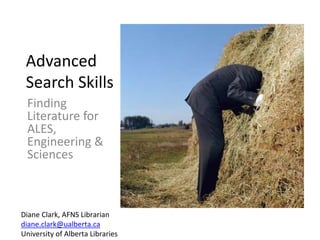Advanced literature search skills for agriculture, engineering and the sciences
- 1. Advanced Search Skills Finding Literature for ALES, Engineering & Sciences Diane Clark, AFNS Librarian diane.clark@ualberta.ca University of Alberta Libraries
- 2. Outline ŌĆó controlled vocabulary ŌĆó natural language / keywords & phrases ŌĆó Boolean operators ŌĆó proximity locators ŌĆó highly cited papers 2
- 3. Why? = horse chestnut playing conkers chestnut flower conker moth Under the Chestnut tree Horse chestnut supplement Chestnut horse
- 4. ŌĆó Databases control how your search terms are performed ŌĆó There is no interpretation of your information need(s) ŌĆó Work with the database syntax and structure
- 5. Order of Precedence: No Boolean Operators AND OR E.g. stress and fracture fracture stress fields stress fracture gap stress analysis fracture surgery AND OR AND NOT E.g. diabetes childhood and diabetes type 2 diabetes childhood diabetes diabetes in children childhood diabetes mellitus Exact match from left to right E.g. childhood diabetes
- 6. Controlled Vocabulary ŌĆó Metadata ŌĆó LCSH (Library of Congress Subject Headings) ŌĆó MeSH (Medical Subject Headings) ŌĆó Index terms ŌĆó Thesauri
- 7. Sub-headings & number of citations Tree or hierarchy in MedLine Scope Note = More info
- 8. Scope Note ŌĆō information about subject headings
- 9. CABI in Web of Science use CABICODES for controlled vocabulary
- 11. When to use Controlled Vocabulary ŌĆó Established concepts ŌĆó Display relationships between concepts Keywords ŌĆó Newer concepts ŌĆó Interdisciplinary topics ŌĆó New articles (not indexed) usually called ŌĆ£In processŌĆØ ŌĆó Errors in spelling or indexing
- 12. Boolean Operators Operators ŌĆó AND ŌĆó OR ŌĆó NOT When ordering food AND gets you more
- 13. Boolean Operators Operators ŌĆó AND ŌĆó OR ŌĆó NOT When looking for articles in a database, AND = less results
- 14. Boolean Operators Operators ŌĆó AND ŌĆó OR ŌĆó NOT When ordering food OR gives you less
- 15. Boolean Operators Operators ŌĆó AND ŌĆó OR ŌĆó NOT When looking for articles in a database, OR = more results
- 16. Boolean Operators Operators ŌĆó AND ŌĆó OR ŌĆó NOT When ordering food or searching for citations, NOT = removes unwanted items Lettuce, tomato but NOT turkey
- 17. Combining Boolean Operators ŌĆó AND = less ŌĆó OR = more ŌĆó NOT = remove Combining operators 1. small AND poor grammar AND green = Yoda 2. small OR green = Kermit, Hulk, Yoda, Gary Coleman 3. green AND poor grammar = Kermit, Hulk, Yoda
- 18. Order of Precedence: With Boolean Operators NEAR/# SAME NOT AND OR OR W/# AND AND NOT Exact match from left to right Note: Precedence can be controlled using nesting or brackets
- 19. calcifediol OR 25 hydroxy vitamin D OR 25(OH)D OR 25-hydroxyvitamin D child OR children OR teen OR adolescent OR juvenile OR minor OR school aged OR teenager = ? = results are citations with any of the terms above, with the only term that is narrowed is 25-hydroxyvitamin D with child Order of Precedence: Without Nesting Boolean Operators Looking for citations on vitamin D levels in children: AND
- 20. (calcifediol OR 25 hydroxy vitamin D OR 25(OH)D OR 25-hydroxyvitamin D) (child OR children OR teen OR adolescent OR juvenile OR minor OR school aged OR teenager) = results vitamin D levels in a specific population Order of Precedence: Using Nesting Boolean Operators Use brackets ( ) to determine order Searched 1st Searched 2nd AND Sets are combined last
- 21. Phrases & Adjacency Phrase for an Exact Match ŌĆó MedLine ŌĆ£horse chestnutŌĆØ ŌĆó Scopus {horse chestnut} ŌĆó Web of Science ŌĆ£horse chestnutŌĆØ Adjacency/Proximity ŌĆó Medline horse chestnut ADJ5 vitamin ŌĆó Scopus horse-chestnut W/5 vitamin ŌĆó Web of Science horse chestnut NEAR/5 vitamin
- 22. Highly Cited Articles Web of Science Looking for prion disease in chickens Change ŌĆ£Sort byŌĆØ to A highly cited paper is a paper that belongs to the top 1% of papers in a research field published in a specified year. The 1% is determined by the highly cited threshold calculated for the research field in the specified year.
- 23. Highly Cited Articles Web of Science Note: There arenŌĆÖt ŌĆ£highly citedŌĆØ papers in all topics
- 24. Summary 1. Become a registered user of the databases to save searches and get alerts 2. Search more than one database and vary your terms and strategies 3. Finding highly cited authors and papers can be a challenge 4. Ask your librarian to help get you started
- 25. Questions? Ask Your Librarian ŌĆó AFNS diane.clark@ualberta.ca ŌĆó Biology & RenRes christina.hwang@ualberta.ca ŌĆó Chemistry elizabeth.wallace@ualberta.ca ŌĆó Chem Eng, Mat Eng, REES randy.reicardt@ualberta.ca ŌĆó Civil Eng jerry.kowalyk@ualberta.ca ŌĆó Computer Eng sam.popowich@ualberta.ca ŌĆó EAS jthorlak@ualberta.ca ŌĆó Human Ecology angie.mandeville@ualberta.ca ŌĆó Maps virginia.pow@ualberta.ca ŌĆó Math tim.klassen@ualberta.ca
Editor's Notes
- #7: Hierarchy of terms Ideas / concepts Events Places People MeSH ŌĆō provides the true meaning of a term where a word might be used in more than one context Includes synonyms so will search for related terms Manages homonyms and spelling variations or errors Leads to fidning terms not commonly used
























